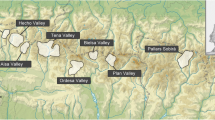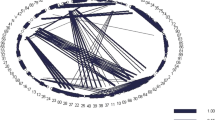Abstract
The vast majority of bats strongly depend on, but do not make, shelters or roosts. We investigated Lophostoma silvicolum, which roosts in active termite nests excavated by the bats themselves, to study the relationship between roost choice and mating systems. Due to the hardness of the termite nests, roost-making is probably costly in terms of time and energy for these bats. Video-observations and capture data showed that single males excavate nests. Only males in good physical condition attracted females to the resulting roosts. Almost all groups captured from excavated nests were single male-multifemale associations, suggesting a harem structure. Paternity assignments based on ten polymorphic microsatellites, revealed a high reproductive success of 46% by nest-holding males. We suggest that the mating system of L. silvicolum is based on a resource-defense polygyny. The temperatures in the excavated nests are warm and stable, and might provide a suitable shelter for reproductive females. Reproductive success achieved by harem males appears to justify the time and effort required to excavate the nests. Reproductive success may thus have selected on an external male phenotype, the excavated nests, and have contributed to the evolution of an otherwise rare behavior in bats.



Similar content being viewed by others
References
Andersson M (1994) Sexual selection. Princeton University Press, Princeton, NJ
Anthony ELP (1988) Age determination in bats. In: Kunz TH (ed) Ecological and behavioral methods for the study of bats. Smithsonian Institution, Washington, DC, pp 47–58
Balasingh J, Koilraj J, Kunz TH (1995) Tent construction by the short-nosed fruit bat Cynopterus Sphinx (Chiroptera, Pteropodidae) in Southern India. Ethology 100:210–229
Bhat HR, Kunz TH (1995) Altered flower fruit clusters of the kitul palm used as roosts by the short-nosed fruit bat, Cynopterus Sphinx (Chiroptera, Pteropodidae). J Zool 235:597–604
Bockholdt C (1998) Hangplatzwahl, Aktivitätsrhythmik und Aktionsraum der neotropischen Fledermaus Tonatia silvicola (D’Orbigny, 1836). University of Freiburg
Bradbury JW, Vehrencamp SL (1976) Social organization and foraging in emballonurid bats. Behav Ecol Sociobiol 2:19–29
Brightsmith DJ (2000) Use of arboreal termitaria by nesting birds in the Peruvian Amazon. Condor 102:529–538
Brooke AP (1990) Tent selection, roosting ecology and social-organization of the tent-making bat, Ectophylla alba, in Costa-Rica. J Zool 221:11–19
Clutton-Brock TH (1988) Reproductive success. University of Chicago Press, London
Clutton-Brock TH (1989) Mammalian mating systems. Proc R Soc Lond B 236:339–372
Collias NE (1964) The evolution of nests and nest-building in birds. Am Zool 4:175–190
Dawkins R (1976) The selfish gene. Oxford University Press, Oxford
Dawkins R (1999) The extended phenotype: the long reach of the gene, 2nd edn. Oxford University Press, Oxford
Dechmann DKN, Garbely E, Kerth G, Garner TWJ (2002) Highly polymorphic microsatellites for the study of the round-eared bat, Tonatia silvicola (d’Orbigny). Conserv Gen 3:455–458
Dechmann DKN, Kalko EKV, Kerth G (2004) Ecology of an exceptional roost: energetic benefits could explain why the bat Lophostoma silvicolum roosts in active termite nests. Evol Ecol Res 6:1037–1050
Dietz HF, Snyder TE (1924) Biological notes on the termites of the canal zone and adjoining parts of the republic of Panama. J Agric Res 26:279–302
Emlen ST, Oring LW (1977) Ecology, sexual selection, and evolution of mating systems. Science 197:215–223
Foster RB, Brokaw NVL (1982) Structure and history of the vegetation of Barro Colorado Island. In: Leigh EG Jr, Rand AS, Windsor DM (eds) The ecology of a tropical forest. Smithsonian Institution, Washington DC, pp 151–172
Hansell MH (1984) Animal architecture and building behaviour. Longman, London
Hansell MH, Deeming DC (2002) Location, structure and function of incubation sites. In: Deeming DC (ed) Avian incubation. Oxford University Press, Oxford, pp 8–27
Heckel G, Voigt CC, Mayer F, Von Helversen O (1999) Extra-harem paternity in the white-lined bat Saccopteryx bilineata (Emballonuridae). Behaviour 136:1173–1185
Hodgkison R, Balding ST, Akbar Z, Kunz TH (2003) Roosting ecology and social organization of the spotted-winged fruit bat, Balionycteris maculata (Chiroptera : Pteropodidae), in a Malaysian lowland dipterocarp forest. J Trop Ecol 19:667–676
Kalko EKV, Handley CO, Handley D (1996) Organization, diversity, and long-term dynamics of a Neotropical bat community. In: Cody ML, Smallwood JA (eds) Long-term studies of vertebrate communities. Academic, San Diego, pp 503–553
Kalko EKV, Friemel D, Handley CO, Schnitzler HU (1999) Roosting and foraging behavior of two Neotropical gleaning bats, Tonatia silvicola and Trachops cirrhosus (Phyllostomidae). Biotropica 31:344–353
Kempenaers B, Congdon B, Boag P, Robertson RJ (1999) Extrapair paternity and egg hatchability in tree swallows: evidence for the genetic compatibility hypothesis? Behav Ecol 10:304–311
Kerth G, König B (1996) Transponder and an infrared-videocamera as methods used in a fieldstudy on the social behaviour of Bechstein’s bat (Myotis bechsteinii). Myotis 34:27–34
Kleiman DG, Malcolm JR (1981) The evolution of male parental investment in mammals. In: Gubernick DJ, Klopfer PH (eds) Parental care in mammals. Plenum, New York, pp 347–387
Kunz TH (1982) Roosting ecology of bats. In: Kunz T (ed) Ecology of bats. Plenum, New York, pp 1–55
Kunz TH, Hood WR (2000) Parental care and postnatal growth in the Chiroptera. In: Crichton EG, Krutzsch PH (eds) Reproductive biology of bats. Academic, London, pp 415–454
Kunz TH, Lumsden LF (2003) Ecology of cavity and foliage roosting bats. In: Kunz TH, Fenton MB (eds) Bat ecology, 1st edn. University of Chicago Press, Chicago, pp 3–90
Kunz TH, August PV, Burnett CD (1983) Harem social-organization in cave roosting Artibeus jamaicensis (Chiroptera, Phyllostomidae). Biotropica 15:133–138
Kunz TH, Robson SK, Nagy KA (1998) Economy of harem maintenance in the greater spear-nosed bat, Phyllostomus hastatus. J Mammal 79:631–642
Lee TE, Hoofer SR, Van Den Bussche RA (2002) Molecular phylogenetics and taxonomic revision of the genus Tonatia (Chiroptera: Phyllostomidae). J Mammal 83:49–57
Lewis SE (1995) Roost fidelity of bats—a review. J Mammal 76:481–496
Marshall TC, Slate J, Kruuk LEB, Pemberton JM (1998) Statistical confidence for likelihood-based paternity inference in natural populations. Mol Ecol 7:639–655
McCracken GF, Bradbury JW (1981) Social organization and kinship in the polygynous bat Phyllostomus hastatus. Behav Ecol Sociobiol 8:11–34
McElligott AG, Gammell MP, Harty HC, Paini DR, Murphy DT, Walsh JT, Hayden TJ (2001) Sexual size dimorphism in fallow deer (Dama dama): do larger heavier males gain greater mating success? Behav Ecol Sociobiol 49:266–272
McElligott AG, Naulty F, Clarke WV, Hayden TJ (2003) The somatic cost of reproduction: what determines reproductive effort in prime-aged fallow bucks? Evol Ecol Res 5:1239–1250
Morrison DW, Morrison SH (1981) Economics of harem maintenance by a Neotropical bat. Ecology 62:864–866
Müllenbach R, Lagoda PJL, Welter C (1989) An efficient salt chloroform extraction method of DNA from blood and tissues. Trends Genet 5:391
Ortega J, Arita HT (2000) Defence of females by dominant males of Artibeus jamaicensis (Chiroptera: Phyllostomidae). Ethology 106:395–407
Ortega J, Maldonado JE, Arita HT, Wilkinson GS, Fleischer RC (2002) Characterization of microsatellite loci in the Jamaican fruit-eating bat Artibeus jamaicensis and cross-species amplification. Mol Ecol Notes 2:462–464
Ortega J, Maldonado JE, Wilkinson GS, Arita HT, Fleischer RC (2003) Male dominance, paternity, and relatedness in the Jamaican fruit-eating bat (Artibeus jamaicensis). Mol Ecol 12:2409–2415
Queller DC, Goodnight KF (1989) Estimating relatedness using genetic-markers. Evolution 43:258–275
Racey PA (1988) Reproductive assessment in bats. In: Kunz TH (ed) Ecological and behavioral methods for the study of bats. Smithsonian Institution Press, Washington, DC, pp 277–302
Racey PA, Entwistle AC (2000) Life-history and reproductive strategies of bats. In: Crichton EG, Krutzsch PH (eds) Reproductive biology of bats. Academic, London, pp 364–401
Ralls K (1977) Sexual dimorphism in mammals—avian models and unanswered questions. Am Nat 111:917–938
Reid FA (1997) A field guide to the mammals of Central America and Southeast Mexico. Oxford University Press, New York
Ruckstuhl KE, Neuhaus P (2002) Sexual segregation in ungulates: a comparative test of three hypotheses. Biol Rev 77:77–96
Slate J, Marshall T, Pemberton J (2000) A retrospective assessment of the accuracy of the paternity inference program CERVUS. Mol Ecol 9:801–808
Speakman JR, Thomas DW (2003) Physiological ecology and energetics of bats. In: Kunz TH, Fenton MB (eds) Bat ecology, 1st edn. University of Chicago Press, Chicago, pp 430–492
Storz JF, Kunz TH (1999) Cynopterus sphinx. Mamm Species 613:1–8
Storz JF, Bhat HR, Kunz TH (2000) Social structure of a polygynous tent-making bat, Cynopterus sphinx (Megachiroptera). J Zool 251:151–165
Storz JF, Balasingh J, Bhat HR, Nathan PT, Doss DPS, Prakash AA, Kunz TH (2001a) Clinal variation in body size and sexual dimorphism in an Indian fruit bat, Cynopterus sphinx (Chiroptera: Pteropodidae). Biol J Linn Soc 72:17–31
Storz JF, Bhat HR, Kunz TH (2001b) Genetic consequences of polygyny and social structure in an Indian fruit bat, Cynopterus sphinx. II. Variance in male mating success and effective population size. Evolution 55:1224–1232
Ueberschaer K (1999) Untersuchung zur Hangplatzökologie der neotropischen Fledermaus Tonatia silvicola unter Berücksichtigung der Sozialstruktur und des Reproduktionsstatus. University of Würzburg
Voigt CC, von Helversen O (1999) Storage and display of odour by male Saccopteryx bilineata (Chiroptera, Emballonuridae). Behav Ecol Sociobiol 47:29–40
Wilde CJ, Knight CR, Racey PA (1999) Influence of torpor on milk protein composition and secretion in lactating bats. J Exp Zool 284:35–41
Windsor DM (1990) Climate and moisture variability in a tropical forest: long-term records from Barro Colorado Island, Panama. Smithson Contrib Earth Sci 29:1–145
Acknowledgements
This project was supported by grants from the Roche Research Foundation and the ZUNIV-Fonds zur Förderung des Akademischen Nachwuchses (FAN). The Julius-Klaus-Stiftung (Zürich) and the Brachet Foundation (Belgium) financed the genetic analyses. We are grateful to the Smithsonian Tropical Research Institute (STRI) and the National Authority for the Environment (ANAM) for research permits, which ensured that all work was carried out in concordance with current Panamanian laws. We also want to thank the staff of Barro Colorado Island, especially the game wardens, for their support. The following people helped with fieldwork, development of equipment and/or with data analysis: A. Beck, M. Demir, S. Heucke, M. Kalka, J. Mandel, F. Neuhäuser-Wespy, K. and K. Safi, A. Schulz, M. Weinbeer, S. Wetterich, and especially A. Lang, S. Spehn, and C. Weise. Special thanks for help with the genetic work are owed to J. Garbely and T. Garner. We also thank J. Bradbury, L. di Iorio, T. Kunz, G. McCracken, A. McElligott, G. Wilkinson, and an anonymous reviewer for valuable comments on the manuscript.
Author information
Authors and Affiliations
Corresponding author
Additional information
Communicated by G. Wilkinson
Rights and permissions
About this article
Cite this article
Dechmann, D.K.N., Kalko, E.K.V., König, B. et al. Mating system of a Neotropical roost-making bat: the white-throated, round-eared bat, Lophostoma silvicolum (Chiroptera: Phyllostomidae). Behav Ecol Sociobiol 58, 316–325 (2005). https://doi.org/10.1007/s00265-005-0913-y
Received:
Revised:
Accepted:
Published:
Issue Date:
DOI: https://doi.org/10.1007/s00265-005-0913-y




